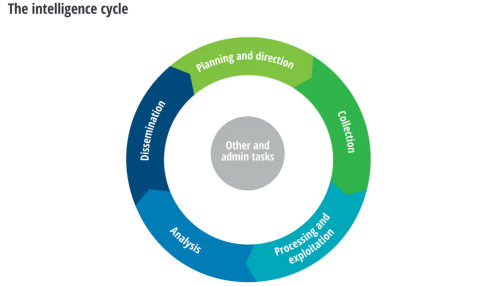Artificial intelligence in the intelligence cycle
Intelligence flows through experts, analysts, and management throughout the IC through a five-step "cycle": planning and direction; collection; processing; analysis and production; and dissemination (see figure below).

The value of the output throughout the cycle, including the finished intelligence that analysts deliver to decision makers, is largely determined by the technologies and processes used, including those that leverage artificial intelligence.
Technologies such as unmanned aerial systems, remote sensors, advanced surveillance aircraft, the Internet, computers and other systems have hypernormalized the collection process to the point that analysts often have more data than they can process.
Getting more data should be a good thing. But without the ability to fuse and process data, data can overwhelm analysts with mountains of disconnected information. The director of the National Geospatial-Intelligence Agency said that if trends hold, intelligence organizations may soon need more than 8 million imagery analysts, more than five times the total number of top-secret clearances across the entire government. In the modern digital age, success in warfare depends on a nation's ability to analyze information faster and more accurately than its adversary, and data must be analyzed.
Artificial intelligence can provide much-needed support. Intelligence agencies are already harnessing the power of artificial intelligence to sort through vast amounts of data to extract key "knowns" for further analysis. For example, agencies have used artificial intelligence to automatically identify and tag patterns in vehicles to identify SA-21 surface-to-air missile batteries, or to sift through millions of financial transactions for patterns consistent with illicit arms smuggling. Likewise, the Joint Artificial Intelligence Center is already working to develop products covering "combat intelligence fusion, joint all-domain command and control, accelerated sensor-to-shooter timelines, autonomous and swarm systems, targeting development, and operations center workflows."
When analyzed, artificial intelligence operating with these capabilities can save analysts time and increase output. While the exact time savings depend on the type of work performed, an all-source analyst backed by an artificial intelligence system can save as much as 364 hours or more than 45 workdays per year. These time savings can free up analysts to spend on higher priority tasks, or build skills through additional training, among other activities.
銆怤etwork Security銆戔棌9 popular malicious Chrome extensions
銆怬pen Source Intelligence銆戔棌5 Hacking Forums Accessible by Web Browsers
銆怤ews銆戔棌Access control giant hit by ransom attack, NATO, Alibaba, Thales and others affected
銆怰esources銆戔棌The 27 most popular AI Tools in 2023
【News】●AI-generated fake image of Pentagon explosion goes viral on Twitter



